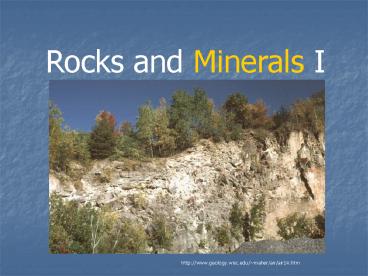Rocks and Minerals I - PowerPoint PPT Presentation
Title:
Rocks and Minerals I
Description:
Title: Slide 1 Author: Dr. Barbara Gage Last modified by: sroot Created Date: 5/1/2005 11:55:07 PM Document presentation format: On-screen Show (4:3) – PowerPoint PPT presentation
Number of Views:35
Avg rating:3.0/5.0
Title: Rocks and Minerals I
1
Rocks and Minerals I
http//www.geology.wisc.edu/maher/air/air14.htm
2
What distinguishes rocks from minerals?
- Composition
- A mineral is homogeneous and has a fixed
composition. It is formed through natural
processes and is usually inorganic. It has a
defined crystal structure.
John Veevaert
John H. Betts
3
What distinguishes rocks from minerals?
- Composition
- A rock is heterogeneous and formed from two or
more minerals.
Andrew Alden
http//www2.vscc.cc.tn.us/svinson/geo100/sedimenta
ry.html
4
Minerals
- Lets take a look at some of the characteristics
of minerals and their tests.
Lou Perloff
5
Mineral Formulas
- A mineral has a definite chemical formula such
as NaCl, called halite CuAl6(PO4)4(OH)84(H2O),
known as turquoise or (K(Mg,Fe)3AlSi3O10)(OH)2)
which is biotite.
John Betts
6
Mineral Color
Color alone is not the best identifier of a
mineral because even small inclusions may change
the color you see. These photos are varied
forms of quartz.
Patrick Laird
Mike Streeter
Patrick Laird
Floyd Hawk
7
Mineral Streak
- The powdered color of a mineral is
characteristic. You can see the color by
dragging the mineral across a rough surface. The
result is called a streak.
Patrick Laird
http//geology.csupomona.edu/alert/mineral/streak.
htm
8
Mineral Luster
Lusters metallic shiny dull
non-metallic adamantine earthy pearly silky g
reasy resinous glassy
- Mineral luster is a term for describing the way
light is reflected from the surface of a mineral.
Galena - metallic
http//webmineral.com/data/Galena.shtml
Spodumene glassy http//webmineral.com/specimens
/picshow.php?id1091
9
Mineral Hardness
Diamond hardest
- Hardness is a minerals resistance to being
scratched. A harder mineral will scratch a
softer one. Hardness is a relative measure and
is assigned a number based on the Mohs Scale.
Lou Perloff
Talc softest
www.yuprocks.com
10
Mineral Hardness
Hardness (Mohs) Mineral Absolute Hardness
1 Talc (Mg3Si4O10(OH)2) 1
2 Gypsum (CaSO42H2O) 3
3 Calcite (CaCO3) 9
4 Fluorite (CaF2) 21
5 Apatite (Ca5(PO4)3(OH-,Cl-,F-)) 48
6 Orthoclase Feldspar (KAlSi3O8) 72
7 Quartz (SiO2) 100
8 Topaz (Al2SiO4(OH-,F-)2) 200
9 Corundum (Al2O3) 400
10 Diamond (C) 1500
2.5 Fingernail
2.53 Gold, Silver
3 Copper penny
4-4.5 Platinum
4-5 Iron
5.5 Knife blade
6-7 Glass
6.5 Iron pyrite
7 Hardened steel file
11
Density or Specific Gravity
- All minerals have a density. Densities that are
high or low may be helpful in identifying the
mineral.
Density is the amount of matter in a given volume
of the substance. DM/V Specific gravity is the
density of a substance compared to the density of
water. Because specific gravity is a ratio with
no units, it is often used in the place of
density.
Galena very dense
Gypsum low density
http//www.spaceman.ca/mineral/index.php?ViewImage
110
12
Other Mineral Properties
Some carbonate minerals react to an acid such as
HCl. The reaction produces carbon dioxide gas
which will fizz on the mineral surface.
http//geology.csupomona.edu/alert/mineral/other.h
tm
Some minerals show magnetism or are attracted to
magnets. Magnetite is the best example and has
been used to make magnets.
http//www.yourgemologist.com/magnetite.html
13
Identifying a Mineral
- When geologists or gemologists identify a mineral
they use several properties. The properties they
select depend on the sample itself and what they
suspect the substance is.
http//www.minerals.si.edu/images/gallery/mineral.
htm































